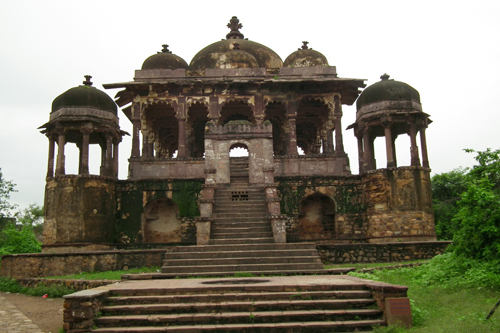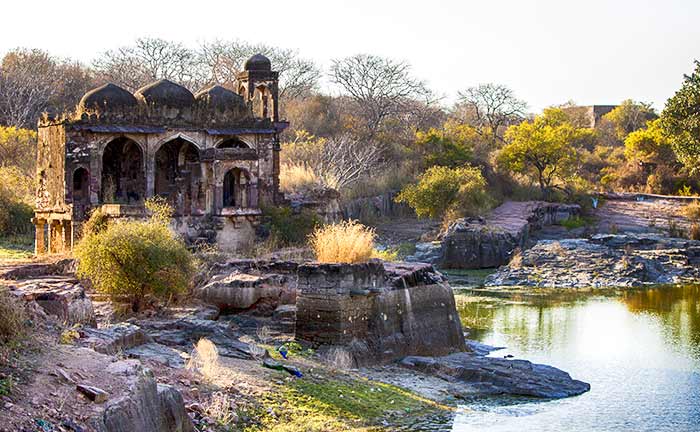A Haunted Tale of Devotion and Dread
Nestled within the rugged Aravalli and Vindhya hills of Rajasthan’s Ranthambore National Park, Ranthambore Fort is a 10th-century UNESCO World Heritage Site renowned for its impregnable walls, ancient temples, and breathtaking views over the tiger-filled jungle. Located 11 km from Sawai Madhopur, this majestic fort, once a stronghold of Rajput and Mughal rulers, is a magnet for history buffs, wildlife enthusiasts, and pilgrims visiting its sacred Ganesh and Jain temples. Yet, beneath its grandeur lies a chilling legend: The Ghostly Monk of Ranthambore Fort, a spectral Jain ascetic whose mournful chants and shadowy presence haunt the fort’s ruins, especially after dusk. As one of Rajasthan’s most intriguing haunted places, this eerie tale draws thrill-seekers and paranormal enthusiasts. In this blog, we unravel the haunting story of the Ghostly Monk, explore the fort’s storied past, and reveal why this Rajasthan landmark is a must-visit for those brave enough to face its mysteries.
Ranthambore Fort: A Historic Stronghold with a Haunted Aura
Founded in 944 CE by the Chauhan Rajputs, Ranthambore Fort is one of India’s oldest and most impregnable forts, strategically perched on a 700-foot hill within Ranthambore National Park, 130 km from Jaipur. Spanning 7 km in circumference, it features massive stone gateways, crumbling palaces, and sacred sites like the Trinetra Ganesh Temple and Jain temples dedicated to Lord Sumatinath and Lord Sambhavanath. The fort witnessed fierce battles, including sieges by Alauddin Khilji in 1301 and Akbar in 1568, earning its reputation as a symbol of Rajput valor. Today, managed by the Archaeological Survey of India (ASI), it’s accessible via a 4-km jeep or footpath from Sawai Madhopur, open daily from 6 AM to 6 PM with free entry.
Despite its daytime allure—offering panoramic views and tiger-spotting opportunities—the fort transforms at night into an eerie labyrinth of dark corridors and bat-filled ruins. Its isolation, coupled with tales of fallen warriors and spiritual figures, fuels its haunted reputation, rivaling Rajasthan’s more famous spooky sites like Bhangarh Fort and Kuldhara Village. The legend of the Ghostly Monk, tied to the fort’s Jain heritage, adds a unique layer to its mystique, making it a hotspot for paranormal lore.

The Legend of the Ghostly Monk
The Ghostly Monk is a spectral figure rooted in Ranthambore Fort’s spiritual history, particularly its Jain temples. Local folklore tells of Acharya Vimalachandra, a revered Jain monk who resided in the fort during the 13th century, a turbulent era of invasions by the Delhi Sultanate. Known for his asceticism and devotion to Lord Sumatinath, Vimalachandra meditated in a cave near the Jain temple, guiding the fort’s residents toward non-violence and spiritual purity. As Alauddin Khilji’s army besieged the fort in 1301, the monk urged the Chauhan defenders to surrender peacefully, believing violence would desecrate the sacred site. His pleas were ignored, and the ensuing battle saw thousands perish, including the monk, who—according to legend—was betrayed and killed by a warrior fearing his influence would weaken the fort’s defense.
Vimalachandra’s death, without attaining moksha (liberation), is said to have bound his spirit to the fort. Known as the Ghostly Monk, he appears as a gaunt figure in saffron robes, his bald head glinting under moonlight, chanting Jain mantras like Namokar Mantra in a hollow voice. His presence is most felt near the Jain temple and the fort’s northern ramparts, where he’s seen meditating or gliding silently. Visitors report hearing his chants echoing through the ruins, feeling a heavy sadness, or glimpsing his shadow vanishing into the cave. Some believe he seeks to protect the fort’s sanctity, while others claim his restless soul mourns the bloodshed that defied his teachings, making him a symbol of spiritual unrest in Rajasthan’s haunted lore.
Paranormal Encounters at Ranthambore Fort
Ranthambore Fort’s haunted reputation is bolstered by chilling accounts from visitors, locals, and temple priests:
- Monk’s Apparitions: Tourists and pilgrims report seeing a saffron-robed figure near the Jain temple or northern ramparts, often at dusk, vanishing when approached. A 2023 travel blog mentions a hiker spotting a monk-like shadow in the cave, accompanied by faint chants.
- Eerie Chants: The sound of Namokar Mantra or mournful humming echoes through the fort after sunset, attributed to the Ghostly Monk. A 2024 YouTube vlog captures unexplained vocalizations near the temple.
- Heavy Presence: Visitors describe an oppressive sadness or cold spots near the cave, with some feeling watched. A 2022 Tripadvisor review notes a pilgrim’s unease during evening prayers, sensing an invisible presence.
- Mysterious Lights: Flickering orbs or lights are reported near the ramparts, believed to be the monk’s spiritual energy. A 2025 local guide’s account describes a glowing figure startling trekkers.
- Dream Warnings: Some staying at nearby resorts, like Aamaghati Resort, report dreams of a monk warning them to respect the fort’s sanctity, shared in a 2025 X post.
Paranormal investigators have visited the fort, noting EMF spikes near the Jain temple but no definitive proof. Locals, including Sawai Madhopur shopkeepers, share tales of the monk’s spirit, though ASI officials attribute sightings to the fort’s isolation and wildlife, like bats or leopards, roaming at night.
Historical and Skeptical Perspectives
Ranthambore Fort’s history provides a plausible backdrop for the Ghostly Monk legend. Built in 944 CE, it was a key Chauhan stronghold, later passing to Mughals, Marathas, and Jaipur’s rulers. The 1301 siege by Alauddin Khilji, marked by mass casualties and possible jauhar (self-immolation), left a legacy of tragedy, supporting tales of restless spirits. The fort’s Jain temples, dating to the 12th–13th centuries, highlight its spiritual significance, making a monk’s presence credible. The cave near the Sumatinath temple, used for meditation, aligns with the legend’s setting.
Skeptics offer rational explanations:
- Environmental Factors: The fort’s acoustics amplify sounds like wind or bat squeaks, mistaken for chants. Dim lighting and dense vegetation create optical illusions, simulating apparitions.
- Psychological Effects: The fort’s haunted reputation, amplified by local guides and media, primes visitors for spooky experiences, creating a placebo effect.
- Wildlife Presence: Leopards and bats, common in Ranthambore National Park, may cause noises or shadows, as noted by ASI staff. A 2023 park ranger report cites animal activity for nighttime disturbances.
- Cultural Narratives: The “ghostly monk” mirrors Rajasthan’s churel and djinn stories, reflecting cultural fears of unrested souls, but lacks documented evidence of a specific monk’s death.
- Tourism Boost: Some locals may exaggerate tales to attract thrill-seekers, boosting Sawai Madhopur’s tourism, similar to Bhangarh Fort’s marketing.
Despite skepticism, the consistency of monk-related stories, especially among Jain pilgrims, keeps the legend alive. The ASI’s 6 PM closure, officially for wildlife safety, fuels speculation of paranormal cover-ups, though no such evidence exists.
Ranthambore Fort Today: A Haunted Wildlife Haven
Ranthambore Fort remains a top Rajasthan attraction, accessible via Sawai Madhopur Railway Station (11 km, ₹50–100 by auto) or Jaipur (130 km, 4–5 hours by car). Entry is free, but jeeps (₹500–1,000) or guides (₹200–500) are recommended for the 4-km ascent. The fort pairs perfectly with Ranthambore National Park safaris (₹1,500–3,000), home to tigers like Tigress Riddhi, and nearby stays like Vinayaka Residency (₹2,000–5,000/night) or Aamaghati Resort. Its Ganesh Chaturthi festival draws thousands, blending spirituality with tourism, while its haunted tales, shared on X and travel blogs, attract ghost hunters.
Nearby attractions include Jaisalmer Fort (600 km), Padam Talao Lake, and Surwal Lake, making Ranthambore a hub for history, wildlife, and adventure. The fort’s inclusion in haunted Rajasthan lists, alongside Bhangarh and Nahargarh, enhances its allure, though nighttime access is restricted.
Why Visit Ranthambore Fort? Tips for Travelers
Ranthambore Fort offers a thrilling mix of history, spirituality, and paranormal intrigue, perfect for Rajasthan visitors:
- Best Time: Visit from October to March for pleasant weather, ideal for fort exploration and safaris. Dusk visits amplify the spooky vibe but respect the 6 PM closure.
- Getting There: Take a train to Sawai Madhopur (2.5 hours from Jaipur, ₹150–500) or drive from Delhi (380 km, 7 hours, ₹3,000–5,000 by cab). Autos or jeeps from Sawai Madhopur reach the fort’s base.
- What to See: Explore the Jain temples, Ganesh Temple, and northern ramparts. Pair with a park safari or visit Padam Talao for tiger sightings.
- Ghost Hunting: Visit the Jain temple at twilight with a camera for orbs or chants, but stay in groups and avoid the cave after dark. Join a guided night walk (₹1,000–2,000) outside the fort for spooky tales.
- Safety: Wear sturdy shoes for uneven paths, carry water, and beware of monkeys or leopards. Respect ASI rules to avoid fines.
- Cultural Respect: Honor the fort’s Jain and Hindu heritage, avoiding loud behavior near temples or littering in the park.
Conclusion: Dare to Meet the Ghostly Monk?
The Ghostly Monk of Ranthambore Fort weaves a haunting tale of devotion, betrayal, and spiritual unrest, transforming this Rajasthan stronghold into a paranormal hotspot. Whether his spirit guards the fort’s sanctity or mourns its violent past, his presence adds an eerie allure to its ancient walls. As you climb its rugged steps or pray at its temples, will you hear his mournful chants or glimpse his saffron shadow? Visit Ranthambore Fort to uncover its secrets—but keep your senses sharp as the sun sets over the Aravallis.
Have you explored Ranthambore Fort or heard its ghostly tales? Share your experiences in the comments, and subscribe for more spooky stories from India’s haunted heritage!
Disclaimer: The Ghostly Monk of Ranthambore Fort is based on folklore and anecdotal reports, with no definitive evidence of paranormal activity. Approach with curiosity and respect for Rajasthan’s cultural and historical legacy.
